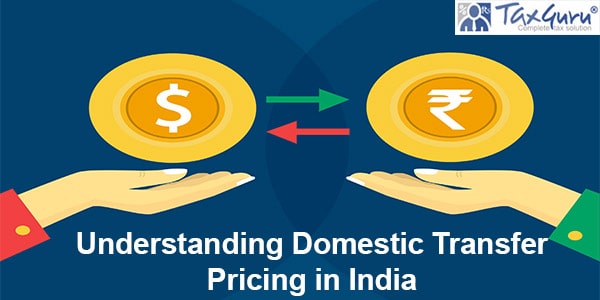Introduction: In the realm of taxation in India, Domestic Transfer Pricing (DTP) has become a crucial aspect, coming into play from the Assessment Year 2013-14. DTP essentially extends Transfer Pricing provisions to specific domestic transactions, creating a framework for governing inter-company transactions within the country.
Legal Definition-
As per the legal definition of domestic transfer pricing-
According to Section 92BA, the defined domestic transactions rule by the TP regulation involves a number of transactions, like –
- Expenses related to integration with a remittance made to a person specified in section 40A(2)(b),
- Transactions specified in section 80A,
- Movement of goods or services as per subsection 8 of section 80-IA,
- Business transactions between the assessee and another person as per subsection 8 of section 80-IA, transactions specified under Chapter VI-A or section 10AA,
- A person to whom laws of subsection 8 or subsection 10 of section 80-IA are applicable.
- And any other transactions as may be specified are considered in the subtotal of such transactions made by the assessee in the preceding year, which exceeds 20 crores.
Threshold limit-
This provision applies only if the total turnover value of the mentioned transactions exceeds Rs. 20 crores (applicable from 1st April 2017, i.e. A.Y. 2017-18 onwards). If the threshold limit has been crossed, the taxpayer must comply with the TP requirements for all transactions, regardless of the value of transactions under any of the heads. Therefore, there is no threshold for each head of the definition.
Applicability of Domestic transfer pricing-
- Domestic transfer pricing doesn’t apply to specific domestic transactions for the purpose of reducing tax liability.
- The monetary threshold limit of 20 crores should be calculated based on the aggregate of payments and receipts to which these provisions apply.
- The definition of related party includes expenses that are disallowed to cover entities with common beneficial ownership.
- Transfer pricing is mostly applicable to international transactions and specified domestic transactions, and it specifically excludes advance pricing agreement provisions.
Arm’s Length Price-
The Arm’s Length Price (ALP) concept is applicable to Specified Domestic Transactions as well. ALP refers to the price that is proposed or applied in a transaction between parties that are unrelated and under uncontrollable conditions. There are different methods to compute the ALP, which include the Comparable Uncontrolled Price Method, Resale Price Method, Cost Plus Method, Profit Split Method, and Transactional Net Margin Method. The Board may notify additional methods as well.

Documentations Requirements-
For domestic transfer pricing transactions, certain documentation requirements need to be fulfilled. These requirements can be broadly classified into four categories:
1. Company-related documentation:
This includes the profile of the company, group companies, units claiming tax holidays, and all related parties.
2. Price-related documentation:
This includes the terms of the transaction, functional analysis specifying functions, assets, and risk, economic analysis containing method, selection, and comparable benchmarking, budgets, and comparables.
3. Transaction-related documentation:
This includes agreements, invoices, and pricing-related correspondence such as emails, letters, etc.
4. Other supporting documentation:
This includes official publication reports by the government, stock exchanges, and financial statements.
Please ensure that all the documentation is accurate, complete, and up-to-date to avoid any complications during the transfer pricing audit.
Issues in Domestic Transfer pricing-
Certain domestic transactions can raise areas of concern-
There is a lack of clarity regarding Indian companies that have both international and domestic transactions. These companies must comply with transfer pricing regulations for their international transactions. However, it is unclear whether they are required to report specified domestic transactions in the following scenarios:
- When the aggregate value of international transactions and specified domestic transactions is less than Rs. 20 crore.
- When the aggregate value of international transactions and specified domestic transactions is more than Rs. 20 crore, but the value of specified domestic transactions is less than Rs. 20 crore.
If the company’s aggregate value of domestic transactions is more than Rs. 20 crore, it is mandatory for them to comply with transfer pricing regulations.
Techniques of Domestic Transfer pricing-
Section 92C (1) prescribed the techniques of arm’s length, which are the following:
CUP (Comparable Uncontrolled Price technique):
This technique compares the price imposed in a managed transaction (among related parties) with the price imposed in a similar unmanaged transaction (among independent parties) under the same circumstances. It is the price for similar or nearly similar property traded between two independent parties under the same or similar circumstances. This method is favored when there is a high degree of equality among the transactions and the markets.
Resale Price Technique:
This method analyzes the gross margin derived by a reseller in a managed transaction (among related parties) with the gross margin earned by a comparable reseller in an unmanaged transaction (among independent parties) under the same circumstances. This technique is appropriate when the reseller/distributor does not add much value to the product and acts as an intermediary.In this technique, the price at which the product or services are resold or offered to an unrelated party is determined. After balancing the gross profit margin and other expenses from resale value, the resulting amount is determined as an arm-length price.
Cost plus Technique:
This technique collates the markup on costs procured by a supplier in a managed transaction (among related parties) with the markup on costs gained by an equivalent supplier in an unmanaged transaction (among independent parties) under the same situations. This technique is suitable when the supplier offers goods or services that are not highly personalized or complex and do not presume significant risks.
Profit Split Technique:
This technique apportioned the combined profit or loss from a controlled transaction (among related parties) among the participants depending on their relative contributions to the value creation. This technique is relevant when the participants are highly unified and interdependent and share significant risks and intangible assets.
(TNMM) Transactional Net Margin technique:
This technique compares the net profit margin gained by a tested party in a managed transaction (among related parties) with the net profit margin gained by an equivalent party in an unmanaged transaction (among independent parties) under the same circumstances. This technique is useful when comparability is required at the transaction level or when multiple transactions must be associated.
*****
About the Author: 
The author is Ruchika Bhagat, FCA helping foreign companies in setting up and closing businesses in India and complying with various tax laws applicable to foreign companies while establishing a business in India. Neeraj Bhagat & Co. Chartered Accountants is a well-established Chartered Accountancy firm founded in the year 1997 with its head office in New Delhi.




